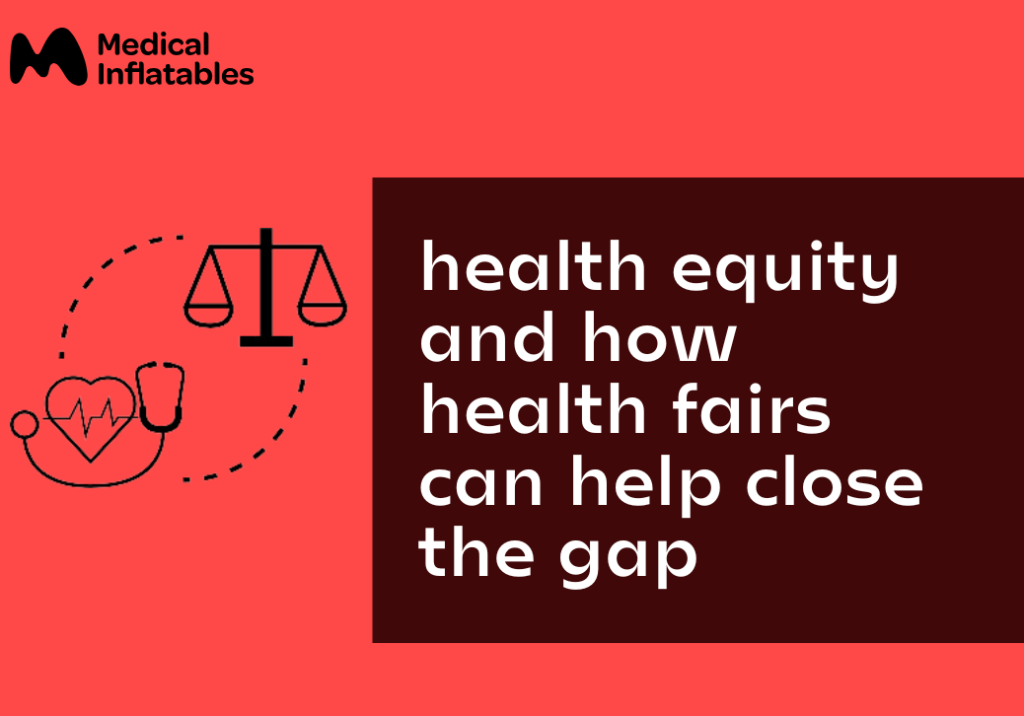
health equity and How Health Fairs Can Help Close the Gap
Health inequity. Health disparity. The health gap. There are nuances to each label, but the gist of it is that health, health education, and healthcare is not the same for everyone. The differences and impact can be broken down by gender, by race or ethnicity, by income, or by geography – any and all of these things can contribute to unequal access to healthcare services, clean air, nutritious food, and safe living environments.
In contrast to health inequity, health equity is the attainment of the highest level of health and health care for all people, emphasizing the need to reduce and ultimately eliminate disparities in health and its determinants.
Some of the data behind health (in)equity
There’s no shortage of studies and data that clearly demonstrate the real-world impact of health inequity. For example:
-The average amount of time women spend in poor health is nine years, which is 25% more time than men. This carries over to productivity and workforce availability, which can decrease earnings and further increase the gender health gap through economic inequality. (Source: McKinsey)
-In the United States, Black and Latino populations experience higher rates of chronic diseases like diabetes, hypertension, and obesity compared to White populations. Yet there are far fewer clinical trials available to these communities for newer diabetes drugs. (Source: NIH)
-Individuals living below the poverty line are significantly more likely to suffer from poor health outcomes. A 2020 study found that people in the lowest income bracket had a life expectancy 12 years shorter than those in the highest income bracket. (Source: NIH)
-Rural residents are more likely to have cancers related to modifiable risks, such as tobacco use, human papillomavirus (HPV), and lack of preventive colorectal and cervical cancer screenings. (Source: NIH)
These are by no means the only data points, and we’ll dive deeper into the risks and impact across various demographics in future blog posts.
how health equity can be achieved
When discussing health equity, it’s essential to recognize the distinction between equality and equity. Equality means giving everyone the same resources, while equity involves distributing resources based on the needs of the recipients. For instance, providing the same healthcare resources to a wealthy neighborhood and a low-income area does not address the underlying disparities; instead, more resources might be needed in the latter to achieve equitable health outcomes.
Addressing these health disparities requires the removal of obstacles to health such as poverty, discrimination, and deep power imbalances. And, while progress towards health equity requires a multifaceted approach, one factor that can be perhaps most easily influenced is the introduction of health education and screening to underserved communities and demographics, through health fairs.
The role of health fairs in achieving health equity
Health fairs can be instrumental in improving health equity by providing essential health services, education, and resources. These community-centered events offer various health services, screenings, and educational materials, for free, or at a low cost.
And they can significantly contribute to promoting health equity in several ways:
Access to health services: Health fairs can offer immediate access to a range of health services that might otherwise be inaccessible – or difficult to access – to underserved populations. Think screenings for blood pressure, cholesterol, diabetes, and cancer, as well as vaccinations and dental check-ups. By bringing these services directly to the community, health fairs can help bridge the gap for individuals who lack regular access to healthcare due to financial constraints, lack of transportation, or other barriers.
Health education and awareness: One of the key components of health fairs is education. Attendees can learn about disease prevention, healthy lifestyles, and the importance of regular medical check-ups. Health professionals may provide valuable information on nutrition, exercise, mental health, and managing chronic conditions. This empowers individuals to take charge of their health and make informed decisions, which is crucial for improving health outcomes in underserved communities.
Early detection and prevention: Many health issues, such as hypertension, diabetes, and certain cancers, can be effectively managed or even prevented if detected early. Health fairs facilitate early detection by providing free or low-cost screenings. Early diagnosis can prevent the progression of diseases and reduce the burden on the healthcare system. For many individuals in low-income or remote areas, health fairs may be their only opportunity for early detection of potential health problems.
Community engagement and trust-building: Health fairs foster a sense of community and trust between healthcare providers and community members. When healthcare professionals engage with the community in a friendly and approachable setting, it can break down barriers of mistrust and cultural misunderstandings. This trust is essential for encouraging individuals to seek medical care when needed and to adhere to medical advice.
Resource distribution: Beyond health services, health fairs often distribute or help open access to essential resources such as healthy food, hygiene products, and information about local health services and support groups. These resources can make a significant difference in the daily lives of individuals who might be struggling to meet their basic needs.
Health fairs are a powerful means of promoting health equity by providing underserved communities with access to essential health services, education, and resources. They address barriers to healthcare access, promote early detection and prevention, and foster community engagement and trust. While challenges remain, the positive impact of health fairs on health equity is undeniable. By continuing to support and expand these initiatives, we can make significant strides toward a more equitable healthcare system where everyone has the opportunity to achieve optimal health.
And if you’re thinking about how to organize or promote your health fair, check out these articles:
> Health Fair Planning Guide
> 8 Steps to Promote Your Health Fair or Health Awareness Event
